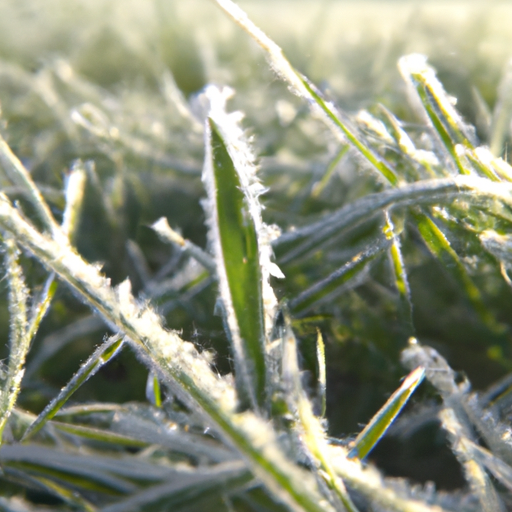
Techniques for Effective Frost Control in Gardens
Mastering the Art of Battling Frost
When it comes to gardening, one of the biggest challenges that gardeners face is frost. Frost can wreak havoc on plants, causing damage and even death. However, with the right techniques for effective frost control, gardeners can protect their plants and ensure their survival.
One of the most effective techniques for battling frost is using frost blankets. Frost blankets are lightweight, breathable fabrics that can be draped over plants to provide protection from frost. These blankets work by trapping heat from the ground and creating a microclimate around the plants. They also allow sunlight and water to reach the plants, ensuring their continued growth and health.
Another technique for effective frost control is using mulch. Mulch acts as an insulating layer, protecting the soil and the roots of plants from freezing temperatures. It also helps to retain moisture in the soil, which is essential for plant survival during frosty conditions. Organic mulches, such as straw or wood chips, are particularly effective at insulating the soil and preventing frost damage.
In addition to using frost blankets and mulch, gardeners can also employ the technique of watering their plants before a frost. Watering the plants before a frost helps to raise the temperature of the plants and the surrounding air. This can provide a temporary buffer against freezing temperatures and help to prevent frost damage. However, it is important to water the plants early enough in the day to allow time for the water to be absorbed before the temperature drops.
Furthermore, gardeners can utilize the technique of using windbreaks to protect their plants from frost. Windbreaks are barriers, such as fences or hedges, that are strategically placed to block the wind. By blocking the wind, windbreaks help to create a more stable microclimate around the plants, reducing the risk of frost damage. It is important to position windbreaks on the side of the prevailing wind to maximize their effectiveness.
Additionally, gardeners can consider using heat sources to protect their plants from frost. Heat sources, such as heat lamps or even Christmas lights, can be placed near plants to provide additional warmth during frosty nights. However, it is crucial to ensure that the heat sources are used safely and do not pose a fire hazard. It is also important to monitor the temperature and adjust the heat sources accordingly to prevent overheating or damage to the plants.
Lastly, gardeners can employ the technique of selecting frost-tolerant plants for their gardens. Frost-tolerant plants are those that can withstand freezing temperatures without suffering significant damage. By choosing frost-tolerant plants, gardeners can minimize the risk of frost damage and ensure the survival of their plants. Some examples of frost-tolerant plants include winter vegetables like kale and Brussels sprouts, as well as evergreen shrubs like boxwood and holly.
In conclusion, battling frost in the garden requires mastering a variety of techniques for effective frost control. From using frost blankets and mulch to watering plants before a frost and utilizing windbreaks and heat sources, there are numerous strategies that gardeners can employ to protect their plants from frost damage. By implementing these techniques and selecting frost-tolerant plants, gardeners can ensure the survival and health of their gardens, even in the face of freezing temperatures.
Essential Tools and Equipment for Battling Frost

Mastering the Art of Battling Frost
When it comes to gardening, battling frost is a challenge that every gardener must face. Frost can wreak havoc on plants, causing damage and even death. However, with the right tools and equipment, you can effectively protect your plants and ensure their survival during frosty conditions.
One essential tool for battling frost is a frost blanket. These blankets are made from a lightweight fabric that allows air and moisture to pass through while providing a protective barrier against frost. Frost blankets can be draped over plants or secured with stakes to create a tent-like structure. They are easy to use and can be quickly deployed when frost is expected.
Another useful tool is a frost cloth. Similar to a frost blanket, a frost cloth is made from a breathable fabric that protects plants from frost. However, frost cloths are typically thicker and provide more insulation. They can be used to cover individual plants or entire rows in the garden. Frost cloths are reusable and can be easily stored when not in use.
In addition to frost blankets and cloths, a frost shield is another valuable tool for battling frost. Frost shields are plastic or fabric covers that are placed directly over individual plants. They create a microclimate around the plant, trapping heat and preventing frost from settling on the leaves. Frost shields are especially useful for protecting delicate plants or those in containers.
To further enhance your frost protection arsenal, consider investing in a frost heater. Frost heaters are small, portable devices that emit heat to keep plants warm during frosty nights. They are typically fueled by propane or electricity and can be placed near vulnerable plants. Frost heaters are particularly effective for protecting plants in greenhouses or cold frames.
In addition to these tools, having a reliable weather station is crucial for battling frost. A weather station will provide you with accurate and up-to-date information on temperature, humidity, and other weather conditions. This information is essential for determining when frost is likely to occur and taking appropriate action to protect your plants.
When using these tools and equipment, it is important to follow some best practices. Firstly, always check the weather forecast regularly to stay informed about potential frost events. Secondly, make sure to cover your plants before sunset, as this is when temperatures typically drop. Lastly, remove the covers in the morning once the sun is up and temperatures have risen above freezing.
In conclusion, battling frost is an essential skill for any gardener. With the right tools and equipment, you can effectively protect your plants and ensure their survival during frosty conditions. Frost blankets, frost cloths, frost shields, frost heaters, and a reliable weather station are all valuable assets in your frost protection arsenal. By following best practices and staying vigilant, you can master the art of battling frost and keep your garden thriving even in the coldest of temperatures.
Tips for Protecting Plants from Frost Damage
Mastering the Art of Battling Frost
When the temperatures drop and frost begins to settle, gardeners and plant enthusiasts alike find themselves faced with the challenge of protecting their beloved plants from frost damage. Frost can be detrimental to plants, causing them to wither and die if not properly protected. However, with a few simple tips and techniques, you can master the art of battling frost and ensure the survival of your plants.
One of the most effective ways to protect plants from frost damage is by covering them. This can be done using a variety of materials, such as blankets, sheets, or even specialized frost protection covers. The key is to create a barrier between the plants and the cold air. When covering your plants, it is important to ensure that the cover reaches all the way to the ground, as this will help trap the heat radiating from the soil and provide additional insulation.
Another important aspect to consider when protecting plants from frost is timing. It is crucial to cover your plants before the frost sets in, ideally in the late afternoon or early evening. This allows the plants to retain as much heat as possible before the temperatures drop. Additionally, it is important to uncover your plants in the morning once the sun has risen and the frost has melted. Leaving the cover on for too long can trap moisture and lead to fungal diseases.
In addition to covering your plants, there are other measures you can take to protect them from frost damage. One such measure is mulching. Applying a layer of mulch around the base of your plants can help insulate the soil and regulate its temperature. This is particularly important for plants with shallow roots, as they are more susceptible to frost damage. Mulch also helps retain moisture, which is essential for plant survival during the cold winter months.
Furthermore, it is important to water your plants before a frost event. Moist soil retains heat better than dry soil, so watering your plants a day or two before the expected frost can help protect them. However, it is important to avoid overwatering, as this can lead to root rot and other issues. The goal is to provide enough moisture to the soil without saturating it.
In addition to these protective measures, it is important to choose frost-tolerant plants for your garden. Some plants are naturally more resistant to frost than others. By selecting plants that are suited to your climate and have a higher tolerance for cold temperatures, you can minimize the risk of frost damage. Additionally, planting in sheltered areas, such as against a wall or near a building, can provide added protection from frost.
In conclusion, mastering the art of battling frost requires a combination of protective measures and careful planning. By covering your plants, timing your actions correctly, mulching, watering appropriately, and selecting frost-tolerant plants, you can significantly reduce the risk of frost damage. Remember, prevention is key when it comes to protecting your plants from the harsh effects of frost. With these tips in mind, you can ensure the survival and thriving of your garden even in the coldest of winters.






